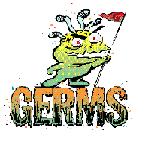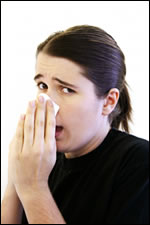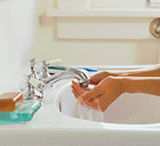

Introduction
Our bodies are pretty amazing. Day after day, they work hard - digesting food, pumping blood and oxygen, sending signals from our brains and our nerves, and much more. But there is a group of tiny invaders that can make our bodies sick - they're called germs.
Some kids may think that germs are bugs or cooties or other gross stuff. Actually, germs are tiny organisms, or living things, that can cause disease. Germs are so small and sneaky that they creep into our bodies without being noticed. In fact, germs are so tiny that you need to use a microscope to see them. When they get in our bodies, we don't know what hit us until we have symptoms that say we've been attacked!
What Types of Germs Are
There?
Germs are found all over the world, in all kinds of places.There
are four major types of germs: bacteria, viruses, fungi, and
protozoa. They can invade plants, animals, and people, and
sometimes they make us sick.
Bacteria are tiny, one-cell creatures that get nutrients from their environments in order to live. In some cases that environment is a human body. Bacteria can reproduce outside of the body or within the body as they cause infections. Some infections bacteria cause include sore throats (called strep throat), ear infections, cavities, and pneumonia.
But not all bacteria are bad. Some bacteria are good for our bodies - they help keep things in balance. Good bacteria live in our intestines and help us use the nutrients in the food we eat and make waste from what's left over. We couldn't make the most of a healthy meal without these important helper germs! Some bacteria are also used by scientists in labs to produce medicines and vaccines.
Viruses can't live outside of living cells. They need to be in or on a living thing like a plant, animal, or person in order to grow and reproduce. Whatever a virus lives in is called its host. When viruses get inside people's bodies, they can spread and make people sick. Viruses cause chicken pox, measles, flu, and many other diseases.
Fungi are multi-cell (made of many cells), plant-like organisms. Unlike other plants, fungi cannot make their own food from soil, water, and air. Instead, fungi get their nutrition from plants, people, and animals. They love to live in damp, warm places, and most fungi are not dangerous. An example of something caused by fungi is athlete's foot, that itchy rash that teens and adults sometimes get between their toes.
Protozoa are one-cell organisms that love moisture and often spread diseases through water. Some protozoa cause intestinal infections that lead to diarrhea (runny poop), nausea, and belly pain.
What Do Germs Do?
Once germs invade our bodies, they snuggle in for a long stay.
They gobble up nutrients and energy, and can produce toxins, which
are like poisons. Those toxins can cause symptoms of common infections,
like fevers, sniffles, rashes, coughing, vomiting, and diarrhea.
How do doctors figure out what germs are doing? They take a closer look. By looking at samples of blood and other fluids under a microscope or sending these samples to a laboratory for more tests, doctors can tell which germs are living in your body and how they are making you sick.
How Can You Protect Yourself
From Germs?
Most germs are spread through the air in sneezes, coughs, or even
breaths. Germs can also spread in sweat, saliva, and blood. Some
pass from person to person by touching something that is contaminated,
like shaking hands with someone who has a cold and then touching
your own nose. So the best way to protect yourself from germs
is to steer clear of the things that can spread them:
* Cover your nose and mouth when you sneeze and cover your mouth when you cough to keep from spreading germs.

|

|
* Remember the two words germs fear - soap and water. Washing your hands well and often is the best way to beat these tiny warriors. Wash your hands every time you cough or sneeze, before and after you prepare foods or use the bathroom, after you handle money, and after you visit a sick relative or friend.

* Using tissues for your sneezes and sniffles is another great weapon against germs. But don't just throw tissues on the floor to pick up later. Toss them in the trash and again, wash your hands!
Now that you know the facts about germs, you may still pick up a cough or a cold once in a while, but you'll be ready to keep most of those invading germs from moving in.
Disclaimer: This information is not intended be a substitute for professional medical advice. It is provided for educational purposes only. You assume full responsibility for how you choose to use this information.
Updated and reviewed by: Mary
L. Gavin, MD
Date reviewed: August 2003
Originally reviewed by: Steven Dowshen, MD, and Stephen Eppes,
MD